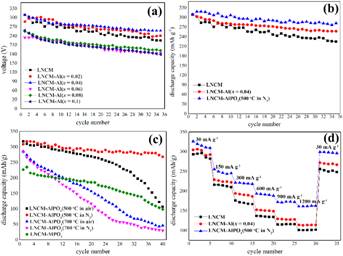| A highly homogeneous nanocoating strategy for Li-rich Mn-based layered oxides based on chemical conversion |
| From: PublishDate:2016-06-03 Hits: |
Lithium rich manganese-based layered oxide (LRMBO) with high capacity exceeding 250 mA h/g is considered as the most promising cathode candidate of Li-ion batteries. But the severe capacity decay hinders its practical application. Prof. Dingguo Xia’s Group, from Beijing Key Laboratory of Theory and Technology for Advanced Battery Materials, has developed a novel strategy for preparing a highly homogeneous nanocoating for Li-rich Mn-based layered oxides. This work has been published in Journal of Power Sources on Jun. 3, 2015. Xia’s group reported a novel nanocoating strategy by the elemental Al doping (LNCMO-Al) followed by chemical conversion in aqueous phosphate buffer solution (PBS). The conversion reaction method ensures uniform contact between the dissolved reagents and bulk particles at the atomic level (LNCMO-AlPO4). The elemental Al uniformly segregates on the particle surfaces layer and provides nucleation sites for the chemical conversion treatment. They figured out the surface phase of as-prepared LNCM, LNCM-MPO4, LNCM-Al, and LNCM-AlPO4 materials by comparing the O K-edges XAS spectra of AlPO4 and LiAlO2 standardswith our as-prepared samples. The resultant AlPO4-nanocoaed Li[Li0.2Ni0.11Co0.11Mn0.54Al0.04]O2 exhibits a greatly enhanced reversible capacity with excellent cycling and superior thermal stabilities relative to the pristine samples. Even under a very high current density of 1200 mA g−1, the LNCM-AlPO4 sample still exhibited a favorable specific capacity of 162.7 mAh g−1 after 30 cycles. More importantly, the LNCM-AlPO4 samples show a much lower heat release of 225 J g−1 at 277.3°C relative to the 1086.7 J g−1 at 216.4°C for the pristine sample.
(a), (b) O K-edge XAS spectra of LNCM, LNCM-AlPO4 (500 °C in N2), LNCM-MPO4, and MPO4. The latter spectrum is included for comparison. (c) O K-edge XAS spectra of LNCM and LNCM-Al (x = 0.04). The LiAlO2 spectrum is presented as a standard for comparison.
(a) Discharge capacity profiles of LNCM and LNCM-Al series samples. (b) Discharge capacity profiles for LNCM, LNCM-Al (x = 0.04), and LNCM-AlPO4 (500 °C in N2) samples. (c) Discharge capacity profiles of LNCM-AlPO4 and LNCM-MPO4. (d) Rate capabilities of LNCM, LNCM-Al (x = 0.04), and LNCM-AlPO4 (500 °C in N2) samples. This work provides a general strategy for the future design of high-capacity electrode system, while the BSRF plays a key role in detecting the electronic structure of the structure. Prof. Xia, the PI of the group, described their work like this, “heterogeneous coatings usually result in compromised functionality of protection in the electrochemical reaction for the materials during practical processing. Therefore, a highly homogeneous nanocoating on the surface of micro or nanoparticles would be extremely desirable. The surface analysis and composition determination play a very important role on material design and production guidance. The hard and soft XAS techniques in BSRF support us a lot in such characterization.” Article: Jin Ma, Biao Li, LiAn, Hang Wei, Xiayan Wang, Pingrong Yu, Dingguo Xia*, A highly homogeneous nanocoating strategy for Li-rich Mn-based layered oxides based on chemical conversion, Journal of Power Sources, 2015, 277, 393–402. |
|
|
| Chinese
- Beamline 1W1 of BSRF started to runoperate in the couplingparasitic mode of BEPCII
- Synthesis of High Performance Polymer Materials for Field Effect-Transistors
- Surfactant molecular aggregates in green solvents
- GIXRD has played an important role in the characterization of organic thin-film transistors
Copyright © 2011 - 2012 Beijing Synchrotron Radiation Facility



